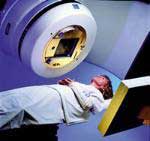The breast is one of the natural beauties and a “source of pride” for women. Moreover, the breast plays a crucial role in a woman’s ability to fulfill her maternal duties after childbirth. However, the risk of breast cancer continues to haunt and threaten women.
 |
A breast cancer patient undergoing radiation therapy |
In many countries, the rate of women diagnosed with breast cancer has been steadily increasing each year. Globally, breast cancer ranks among the leading health risks for women. According to the World Health Organization (WHO), it was estimated that in 2005, around 1.2 million people were diagnosed with breast cancer. The American Cancer Society projected approximately 270,000 new cases would be detected in 2005, equating to 1 in 10 women diagnosed with the disease that year.
In Vietnam, recent studies have shown that breast cancer is the most common type of cancer among women in Hanoi and northern provinces, while it ranks second (after cervical cancer) in Ho Chi Minh City and southern provinces. Annually, there are around 800 new breast cancer cases among 2 million patients examined in Hanoi and about 600 out of 3 million in Ho Chi Minh City, with most patients being over the age of 40.
Due to a lack of awareness, most patients arrive at the hospital when the disease has reached stages 3 and 4 (advanced stages). As a result, these breast cancer cases often require radical mastectomy (complete removal of the breast). This significantly impacts the psychological well-being of the patients.
Dr. Vo Kim Dien, Head of the Oncology Department at FV Hospital, stated that breast cancer is entirely curable if detected at an early stage. The earlier the detection, the higher the chance of a complete cure, especially with the possibility of preserving the breast.
According to statistics from Western countries, about 90% of patients in stage 0 and stage I can be completely cured.
“Breast-conserving surgery has been researched since the 1970s and officially implemented in treatment since the 1990s. This surgical method helps maintain the aesthetic appearance of the breast, ensures quicker recovery post-surgery, and eliminates the need for later breast reconstruction. The rates of recovery, survival time, and recurrence of breast-conserving surgery compared to mastectomy are currently considered equivalent, with treatment costs being similar or even lower,” Dr. Dien remarked.
However, this conservative treatment method is only applicable when the cancer is detected early, when the tumor is smaller than 3cm, and there is no distant metastasis or invasion. The current conservative approach involves removing the tumor, axillary lymph node dissection on the same side, and radiation therapy to the breast and regional lymph nodes. For tumors larger than 3cm, if the patient wishes to preserve the breast, conservative treatment may still be possible, depending on the individual patient’s condition.
According to the experience of Dr. Tran Ngoc Quang, Head of the Oncology and Radiation Therapy Department at Saint-Quentin Hospital (France) and a consultant for the Oncology Department at FV Hospital, if breast cancer is detected when the tumor is smaller than 2cm, the success rate of conservative treatment is high, and the prognosis for the patient is very good. The results of breast-conserving treatment in this case are equivalent to or better than mastectomy.
Preserving the breast through current conservative treatment methods allows women to more easily accept the treatment, alleviating fears and anxieties associated with the complete removal of the breast as per traditional methods.
Dr. Dien advises all women over 40 to perform breast self-examinations correctly and to undergo regular health check-ups annually, including breast examinations. When necessary, doctors will recommend mammograms to detect any suspicious lesions. If the breast is found to be normal after examination, it is recommended to have mammograms every two years.




















































